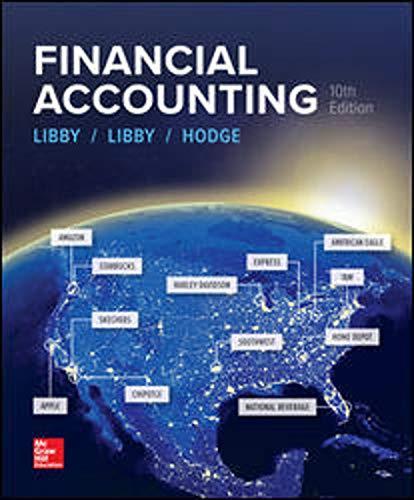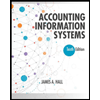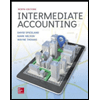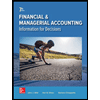
Financial Accounting Fundamentals
6th Edition
ISBN: 9781260005042
Author: Wild
Publisher: MCG
expand_more
expand_more
format_list_bulleted
Question
Chapter 13, Problem 12DQ
To determine
Explain the reasons for difference between return on total assets and return on common stockholders’ equity.
Expert Solution & Answer
Want to see the full answer?
Check out a sample textbook solution
Students have asked these similar questions
Indigo Corporation purchased for $277,000 a 30% interest in Murphy, Inc. This investment enables Indigo to exert significant
influence over Murphy. During the year, Murphy earned net income of $183,000 and paid dividends of $64,000.
Prepare Indigo's journal entries related to this investment. (List all debit entries before credit entries. Credit account titles are automatically
indented when amount is entered. Do not indent manually. If no entry is required, select "No Entry" for the account titles and enter O for the
amounts.)
Account Titles and Explanation
(To record the purchase.)
(To record the net income.)
(To record the dividend.)
Debit
Credit
Indigo Corporation purchased for $277,000 a 30% interest in Murphy, Inc. This investment enables Indigo to exert significant
influence over Murphy. During the year, Murphy earned net income of $183,000 and paid dividends of $64,000.
Prepare Indigo's journal entries related to this investment. (List all debit entries before credit entries. Credit account titles are automatically
indented when amount is entered. Do not indent manually. If no entry is required, select "No Entry" for the account titles and enter O for the
amounts.)
Account Titles and Explanation
(To record the purchase.)
(To record the net income.)
(To record the dividend.)
Debit
Credit
Cheyenne Corporation purchased 400 shares of Sherman Inc. common stock for $12,900 (Cheyenne does not have significant
influence). During the year, Sherman paid a cash dividend of $3.25 per share. At year-end, Sherman stock was selling for $37.00 per
share.
Prepare Cheyenne' journal entries to record (a) the purchase of the investment, (b) the dividends received, and (c) the fair value
adjustment. (Assume a zero balance in the Fair Value Adjustment account.) (List all debit entries before credit entries. Credit account titles
are automatically indented when amount is entered. Do not indent manually. If no entry is required, select "No Entry" for the account titles and
enter O for the amounts.)
No. Account Titles and Explanation
(a)
Debt Investments
Cash
(b)
Cash
Dividend Revenue
(c)
Fair Value Adjustment
Unrealized Holding Gain or Loss - Income
Debit
Credit
Chapter 13 Solutions
Financial Accounting Fundamentals
Ch. 13 - Prob. 1MCQCh. 13 - Prob. 2MCQCh. 13 - Prob. 3MCQCh. 13 - Prob. 4MCQCh. 13 - Prob. 5MCQCh. 13 - Prob. 1DQCh. 13 - Prob. 2DQCh. 13 - Prob. 3DQCh. 13 - Prob. 4DQCh. 13 - Prob. 5DQ
Ch. 13 - Prob. 6DQCh. 13 - Prob. 7DQCh. 13 - Prob. 8DQCh. 13 - Prob. 9DQCh. 13 - Prob. 10DQCh. 13 - Prob. 11DQCh. 13 - Prob. 12DQCh. 13 - Prob. 13DQCh. 13 - Prob. 14DQCh. 13 - Prob. 15DQCh. 13 - Prob. 16DQCh. 13 - Prob. 17DQCh. 13 - Prob. 1QSCh. 13 - Prob. 2QSCh. 13 - Prob. 3QSCh. 13 - Prob. 4QSCh. 13 - Prob. 5QSCh. 13 - Prob. 6QSCh. 13 - Prob. 7QSCh. 13 - Prob. 8QSCh. 13 - Prob. 9QSCh. 13 - Prob. 1ECh. 13 - Prob. 2ECh. 13 - Prob. 3ECh. 13 - Prob. 4ECh. 13 - Prob. 5ECh. 13 - Prob. 6ECh. 13 - Prob. 7ECh. 13 - Prob. 8ECh. 13 - Prob. 9ECh. 13 - Prob. 10ECh. 13 - Prob. 11ECh. 13 - Prob. 12ECh. 13 - Prob. 13ECh. 13 - Prob. 14ECh. 13 - Prob. 15ECh. 13 - Prob. 1APCh. 13 - Prob. 2APCh. 13 - Prob. 3APCh. 13 - Prob. 4APCh. 13 - Prob. 5APCh. 13 - Prob. 6APCh. 13 - Prob. 1BPCh. 13 - Prob. 2BPCh. 13 - Prob. 3BPCh. 13 - Prob. 4BPCh. 13 - Prob. 5BPCh. 13 - Problem 13-6B Income statement computations and...Ch. 13 - Prob. 13SPCh. 13 - Prob. 1BTNCh. 13 - Prob. 2BTNCh. 13 - Prob. 3BTNCh. 13 - Prob. 5BTNCh. 13 - Prob. 7BTNCh. 13 - Prob. 9BTN
Knowledge Booster
Learn more about
Need a deep-dive on the concept behind this application? Look no further. Learn more about this topic, accounting and related others by exploring similar questions and additional content below.Similar questions
- Crane Corporation purchased 360 shares of Sherman Inc. common stock for $11,800 (Crane does not have significant influence). During the year, Sherman paid a cash dividend of $3.25 per share. At year-end, Sherman stock was selling for $34.50 per share. Prepare Crane' journal entries to record (a) the purchase of the investment, (b) the dividends received, and (c) the fair value adjustment. (Assume a zero balance in the Fair Value Adjustment account.) (List all debit entries before credit entries. Credit account titles are automatically indented when amount is entered. Do not indent manually. If no entry is required, select "No Entry" for the account titles and enter O for the amounts.) No. Account Titles and Explanation Debit Credit (a) (b) (c)arrow_forwardIndigo Corporation purchased trading investment bonds for $65,000 at par. At December 31, Indigo received annual interest of $2,600, and the fair value of the bonds was $62,200. Prepare Indigo' journal entries for (a) the purchase of the investment, (b) the interest received, and (c) the fair value adjustment. (Assume a zero balance in the Fair Value Adjustment account.) (List all debit entries before credit entries. Credit account titles are automatically indented when amount is entered. Do not indent manually. If no entry is required, select "No Entry" for the account titles and enter O for the amounts.) No. Account Titles and Explanation Debit Credit (a) (b) (c)arrow_forwardSwifty Corporation purchased trading investment bonds for $40,000 at par. At December 31, Swifty received annual interest of $1,600, and the fair value of the bonds was $37,600. Prepare Swifty' journal entries for (a) the purchase of the investment, (b) the interest received, and (c) the fair value adjustment. (Assume a zero balance in the Fair Value Adjustment account.) (List all debit entries before credit entries. Credit account titles are automatically indented when amount is entered. Do not indent manually. If no entry is required, select "No Entry" for the account titles and enter O for the amounts.) No. Account Titles and Explanation Debit Credit (a) (b) (c)arrow_forward
- about investment securities owned by a company, what do we mean by “significant influence”?arrow_forwardwhat is the working capital?arrow_forwardStatement of Financial position as at September 30 for 2023 and 2024 Assets 2023 2024 Cash and equivalents………………………………………. $56,100 $37,694 Receivables, Trade, less allowances of $1,104 and $991 respectively 47,753 37,645 Other Receivables…………………………………………………… 233 516 Inventories…………………………………………………………… 29,587 23,202 Prepaid expenses and other………………………………………….. 4,739 4,143 Total current assets…………………………………………………... 138,412 103,200 Property, plant and equipment, at cost………………………………. 314,880 298,609 Less accumulated depreciation………………………………………. (225,406) (211,494) Property, plant and equipment net…………………………………… 89,474 87,115 Other assets Goodwill……………………………………………………………...…arrow_forward
- Swifty Corporation had 2025 net income of $1,169,000. During 2025, Swifty paid a dividend of $2 per share on 87,850 shares of preferred stock. During 2025, Swifty had outstanding 301,000 shares of common stock. Compute Swifty's 2025 earnings per share. (Round answer to 2 decimal places, e.g. 3.56.) Earnings per share GA $ per sharearrow_forwardGFH Decorators, a partnership, had the income and expenses shown in the spreadsheet below for the current tax year. Identify whether each item is an "Ordinary Business Income" item (reported on Page 1, Form 1065), a "Separately Stated Item" (reported on Schedule K, Form 1065), or both. Enter the value of ordinary income items in column C and the value of separately stated items in column D. Note that not all the cells in either column C or D will have values. If a response is zero, leave the cell blank.Use a minus sign to enter negative values. A B C D 1 Ordinary Business Income Separately Stated Items 2 Fee revenue $600,000 3 Dividend income $2,000 4 Capital gain distributions $10,000 5 Charitable contributions (cash) ($500) 6 Salaries to employees ($150,000) 7 Partner guaranteed payments ($75,000) 8 MACRS depreciation on office furniture ($3,000) 9 Total ordinary business income $0arrow_forwardexplain why preferred stock is referred to as a "hybrid security"?arrow_forward
- Briefly recap what is meant by "the preemptive right to purchase common stock"? Explain the concept of Stock-Appreciation Rights (SARs).arrow_forwardWhat's the difference between calculating EPS for a simple capital structure versus a complex capital structure?arrow_forwardIn the first two years of operations, a company reports taxable income of $115,000 and $165,000, respectively. In the first two years, the tax rates were 38% and 32% respectively. It is now the end of the third year, and the company has a loss of $160,000 for tax purposes. The company carries losses to the earliest year possible. The tax rate is currently 25%. Required How much tax was paid in year 1 and year 2? Compute the amount of income tax payable or receivable in the current (third) year.arrow_forward
arrow_back_ios
SEE MORE QUESTIONS
arrow_forward_ios
Recommended textbooks for you

 AccountingAccountingISBN:9781337272094Author:WARREN, Carl S., Reeve, James M., Duchac, Jonathan E.Publisher:Cengage Learning,
AccountingAccountingISBN:9781337272094Author:WARREN, Carl S., Reeve, James M., Duchac, Jonathan E.Publisher:Cengage Learning, Accounting Information SystemsAccountingISBN:9781337619202Author:Hall, James A.Publisher:Cengage Learning,
Accounting Information SystemsAccountingISBN:9781337619202Author:Hall, James A.Publisher:Cengage Learning, Horngren's Cost Accounting: A Managerial Emphasis...AccountingISBN:9780134475585Author:Srikant M. Datar, Madhav V. RajanPublisher:PEARSON
Horngren's Cost Accounting: A Managerial Emphasis...AccountingISBN:9780134475585Author:Srikant M. Datar, Madhav V. RajanPublisher:PEARSON Intermediate AccountingAccountingISBN:9781259722660Author:J. David Spiceland, Mark W. Nelson, Wayne M ThomasPublisher:McGraw-Hill Education
Intermediate AccountingAccountingISBN:9781259722660Author:J. David Spiceland, Mark W. Nelson, Wayne M ThomasPublisher:McGraw-Hill Education Financial and Managerial AccountingAccountingISBN:9781259726705Author:John J Wild, Ken W. Shaw, Barbara Chiappetta Fundamental Accounting PrinciplesPublisher:McGraw-Hill Education
Financial and Managerial AccountingAccountingISBN:9781259726705Author:John J Wild, Ken W. Shaw, Barbara Chiappetta Fundamental Accounting PrinciplesPublisher:McGraw-Hill Education


Accounting
Accounting
ISBN:9781337272094
Author:WARREN, Carl S., Reeve, James M., Duchac, Jonathan E.
Publisher:Cengage Learning,

Accounting Information Systems
Accounting
ISBN:9781337619202
Author:Hall, James A.
Publisher:Cengage Learning,

Horngren's Cost Accounting: A Managerial Emphasis...
Accounting
ISBN:9780134475585
Author:Srikant M. Datar, Madhav V. Rajan
Publisher:PEARSON

Intermediate Accounting
Accounting
ISBN:9781259722660
Author:J. David Spiceland, Mark W. Nelson, Wayne M Thomas
Publisher:McGraw-Hill Education

Financial and Managerial Accounting
Accounting
ISBN:9781259726705
Author:John J Wild, Ken W. Shaw, Barbara Chiappetta Fundamental Accounting Principles
Publisher:McGraw-Hill Education
Financial ratio analysis; Author: The Finance Storyteller;https://www.youtube.com/watch?v=MTq7HuvoGck;License: Standard Youtube License